COVID-19 policies relaxed, but students question effectiveness
By Ainsley Harris ’26 Staff Writer


The start of The Claremont Colleges fall 2022 semester brought a relaxation in COVID-19 policies across the 5Cs.
The first and most significant policy change was the reopening of 5C dining. After an increase in COVID cases in the spring 2022 semester, dining was limited to 1C after a little over a month of crosscampus dining, so the reopening of 5C dining was greeted with much enthusiasm from both returning and new students.
Scripps’ residence halls and common rooms opened to all 5C students; however, family members and others outside of The 5Cs are still not allowed access to residence halls. Students are also no longer required to test every week. COVID testing was only required once a week for the first two weeks back on campus, after which testing became optional.
Even with the relaxation of many restrictions, several COVID safety protocols are still in effect. With the start of the semester, the Tiernan Field House opened fully to students; however, in order to access the Tiernan Field House amenities students are required to register for time slots designed to monitor the number of students using the facilities.
While limited as a whole, masking in certain areas – Malott Dining Hall, Garrison Theater, and classes according to teacher discretion – is still required. Surgical grade masks, not cloth, are required in areas with mask mandates.

Scripps maintained some COVID-19 dining hall policies, in contrast to the other Claremont Colleges which lifted dining hall COVID-19 restrictions. While open to 5C dining and allowing indoor seating, Malott remains the only dining hall to require wearing masks inside. In the indoor seating sections, while masks are not required while eating, several round tables have large plastic dividers. These separate the individual seats, and some students dislike the way they are thus separated from their friends.
“The dividers feel pointless and get [in the] way of talking to people,” Dahlia Levy ’26 said. Scripps’ COVID restrictions in general don't
feel useful considering we are all eating in dining halls together, going to classes together, and living together.”
Many students feel as though Scripps’ restrictions are tedious and ineffective. The inconsistency of 5C dining being open, but Malott’s mask mandate paired with the seemingly random placement of table dividers make students feel Scripps’ COVID-19 safety policies are simply to present Scripps as a ‘COVID conscious’ campus rather than to effectively keep students and staff healthy.
The gem of Scripps dining, the Motley, also maintains several COVID regulations. While ordering, students must be masked, but the lounge is mask optional. The line to order drinks is restricted to three people allowed inside the building while the rest of the line extends outside into Seal Court.
Approximately three feet to the left of the line, the area designated for waiting for drinks has no
restrictions and maskless masses congregate.
“I appreciate that Scripps is the campus that still continues to uphold mask mandates, but if they wanted to truly be effective in dining areas they need to rethink the actual policies,” Emma Liang ’26 said.

Scripps’ COVID-19 policies do not end with preventative measures, but extend to several testing and positive response policies. While weekly testing is no longer required, students are required to test within 48 hours of an onset of ‘COVID-like’ symptoms.
Scripps provides its students with easy access to COVID-19 testing. Students can test at the Tranquada Student Services Center Monday through Friday. Student Service Center business hours are Monday - Wednesday 8 a.m. - 5 p.m., Thursday 9 a.m. - 5 p.m., Friday 8 a.m. - 5 p.m., with daily closures from 12 p.m. - 1 p.m. This semester, The Claremont Colleges
introduced six test kit vending machines across the campuses available for submitting test samples Sunday to Friday until 5 p.m. The Scripps vending machine is located at the 240 House Testing Center on 240 E. 11th street, and information on how to use the test kit vending machines can be found at The Claremont Colleges Services website under the COVID-19 test kit vending machines tab.
Isolation policies remain in place for students who tested positive for COVID-19. Upon positive diagnosis students will be sent into isolation for 11 days. At the six day mark, students will be eligible to be released from isolation only if testing comes out negative. If testing remains positive, students will be held in isolation until day 11, after which they will be eligible to leave regardless of a negative COVID-19 test.
For more information on Scripps COVID-19 Policies, please refer to the Scripps Strong Website.

Motley Student Vendors Deloitte, Equity, and Inclusion?
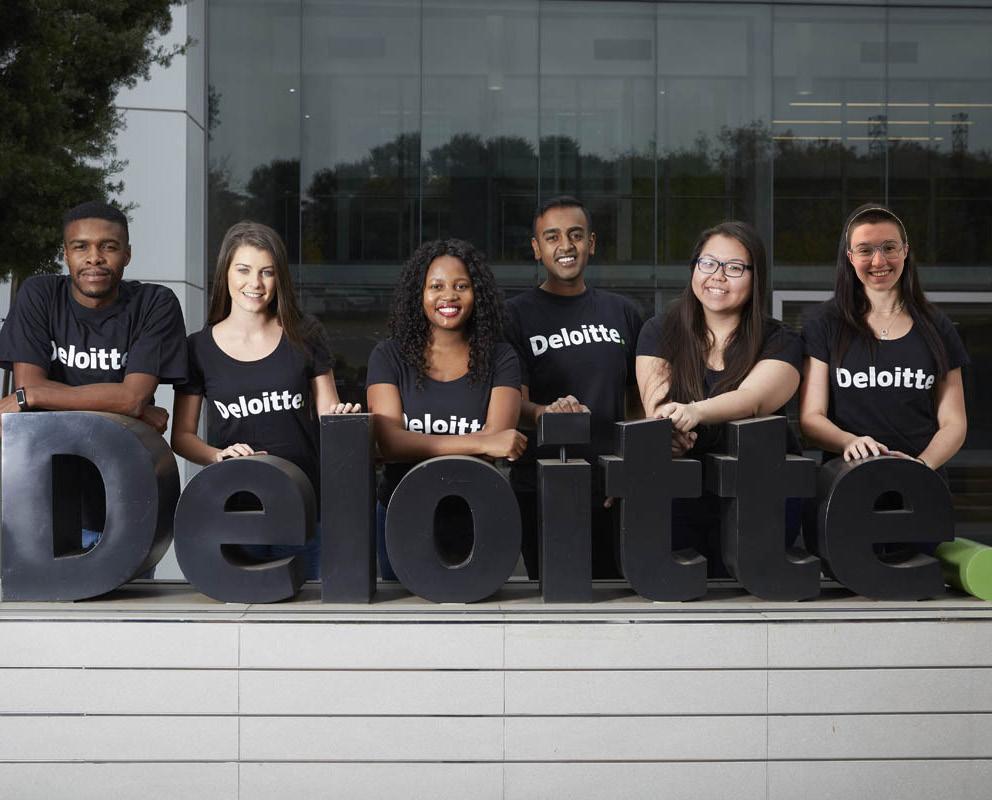
1030 Columbia Avenue | Claremont, CA 91711 | Box 839 | scrippsvoice@gmail.com | Volume XXXI | Issue One scrippsvoice.com 7 October 2022 since 1991 Uncompromising commitment to inclusivity and justice.
IN THIS ISSUE Meet your SAS President Megan Chow! The Perfect Playlist to Put You in the Fall Spirit
Nina Drinks the Haterade
Photo Courtesy of The Claremont Colleges Services
Motley Student Vendors: A Glimpse at the Hands Behind the Jewelry
By Belen Yudess ’25, AJ Jolish ‘25 Social Media Manager, Staff Writer
finished product.
W
hen you visit the Motley Cof feehouse, you can not only get a delicious drink but also sup port Scripps student artists! To in troduce you to some of the faces behind the art, we sat down with three of this year’s vendors: Olive Gaetz ’25, Jenna Wu-Cardona ’23, and Eileen Kang ’26.
The Scripps Voice (TSV): What does making art do for you emo tionally in your life?
Olive Gaetz (OG): It’s really the one thing that I’m passionate about. It’s cathartic. People turn to exercise or writing or playing video games or whatever else; this is my one outlet to get out all the things I’m feeling, get out my creativity, and put something out into the world that I feel happy to have made.
TSV: How do you decide on pricing for your earrings?
OG: There’s a lot of components that go into it. I try to keep a good balance between the time I’ve spent and the materials I’ve used, while keeping in mind that these are college students buying them. My scale right now is usually like nine to twenty dollars, which I found works well and has things go at a steady pace.
Originally, I wasn’t making these for profit, it was just out of enjoy ment. But now I have a purpose for making them, which inspires me to keep experimenting and coming up with new things that I think other people would enjoy.
“[Making earrings] is my one outlet to get out all the things I’m feeling, get out my creativity, and put something out into the world that I feel happy to have made.” - Olive Gaetz ‘25
TSV: Tell me more about the process of making your earrings.
OG: With the embroidered ones, I make a ton at once because if you’re putting the fabric in an em broidery hoop, there’s a certain level of tautness and amount of material you need in order to use it. I fill up as much of the fabric as I can then cut them out, seal them and glue them down to a base, then put on the hoop, attach the hardware, and glue another piece on the back. The embroidery takes a long time because you have to make the two earrings match, which can be difficult because embroidery is a little bit unpredict able, especially at that scale.
Then for the clay earrings, it takes a little bit longer; I create a base out of tin foil, sculpt clay around it, and bake them, which takes around 15 minutes. Then I go to the Hive and I paint them, or just add details. And then let that dry, seal them, and attach jump rings and hooks.
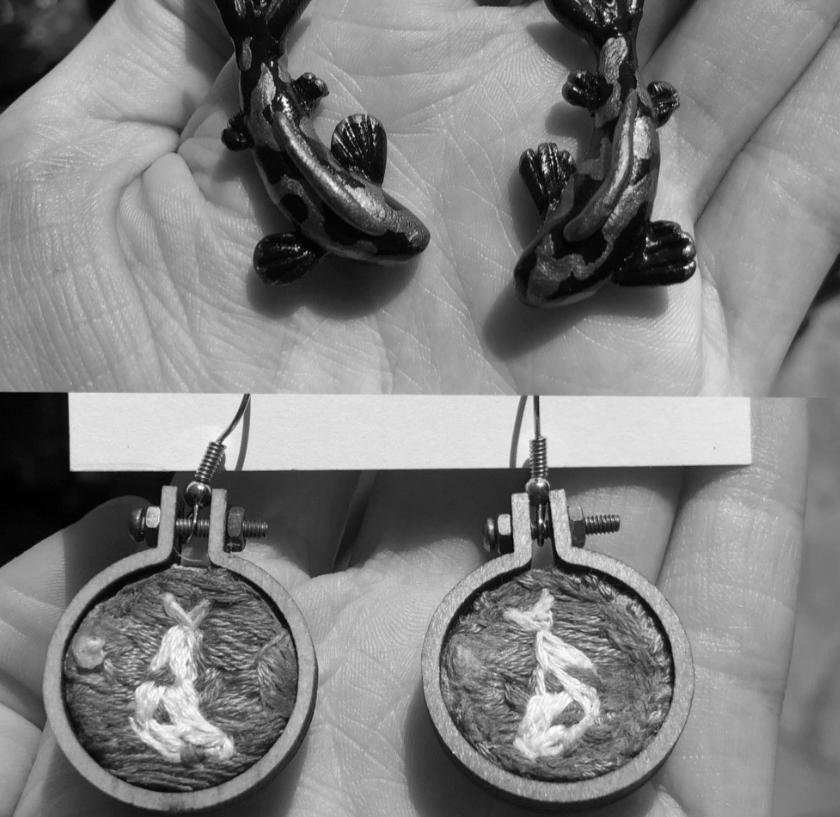
Instagram: @Olivia.Gaetz
TSV: Describe your process from coming up with ideas to the
Jenna Wu-Cardona (JWC): With larger stained glass pieces that I make, a lot of times I’ll do an ab stract collection of shapes based off of word scapes or names of my friends. I’ve given these as gifts before, which is really special and fun. A lot of times the scraps of those pieces — because glass sheets come in pretty big pieces — get turned into earrings. It’s really cool to be able to use those be cause a lot of times with stained glass, you can’t use a lot of it. My mom was the one who taught me how to do stained glass, and she said you just have to get used to wasting a lot of glass, which is re ally devastating. But this way it’s nice to be able to turn it into some thing else.
“Originally, I wasn’t mak ing [earrings] for profit, it was just out of enjoyment. But now I have a purpose for making them, which inspires me to keep experimenting and coming up with new things that I think other people would enjoy.” - Olive Gaetz ‘25

TSV: What was your favorite piece you’ve made for the Motley?
JWC : I don’t know! In selling pieces, I’m always surprised at the process of it, especially in art mar kets or when I can see who they’re going to and what’s going first. A lot of times the pieces that are my very favorites, whether it’s my fa vorite color of glass or I feel like I made it really neatly or something like that, a lot of times those are not the ones that sell. It’s the ones that I think are messy, or are not my personal favorites, that people buy first, which I think is really neat because it shows how personal both the art making process and the art purchasing process are.
TSV : Is there anything else you’d like to say about selling art at the Motley?
JWC: I’d like to share an appre ciation for the ease of the process. A lot of places would take a com mission, but the Motley has stu dents pay artists directly, which is really neat, and very unique and in line with the Motley’s vision.
Instagram: @JWC.Glance
TSV: What do you sell at the Motley and why do you sell that medium?
Eileen Kang (EK): I sell sterling silver jewelry at the Motley. I make bracelets, earrings, rings, neck laces, and they’re all with glass beads, pearls, crystals, and ster ling silver. I started making jewelry because I’m very particular about the things that I want to wear, and I’m very much against tarnishable materials in jewelry. And it’s a re ally good stress relief when I don’t want to do my homework.
TSV: How did you hear about selling your jewelry at the Motley?
EK: At some point before I came here I knew that there was a stu dent run coffeehouse, and that
they sold student made artwork and jewelry, [which] got [me] re ally excited. I was like, wow, that’s great. I can do that. I used to make a lot of stuff, but I wouldn’t real ly sell it because I didn’t want to go through the effort of creating a page and then having to run it. There’s a lot of middlemen stuff with Etsy and Depop. But here it’s really direct. I just put it out and people Venmo me, and they take it. There’s a lot of trust involved, but I trust people here to just not grab things and go.
they receive too. It’s crazy that I can reach this whole community without physically being there, ac tively pushing it. It’s just nice see ing your work in the wild.
Instagram: @shop.kinaesthet ics
“It’s the [pieces] that I think are messy, or are not my per sonal favorites, that people buy first, which I think is really neat because it shows how personal both the art making process and the art purchasing process are.” - Jenna Wu-Cardona ‘23“It’s crazy that I can reach this whole community without physi cally being there... it’s just nice seeing your work in the wild.” -
TSV: How does it feel to see people purchasing your work?
Kang ‘26
EK: It feels like people are ap preciating [my jewelry] and that makes me happy. I hope that they’re very happy with the art that
Gaetz, Wu-Cardona, and Kang are just three of the many student artists who contribute to the Mot ley! Other students sell crochet products, t-shirts, poetry books, and more. So the next time you visit the Motley for a matcha-chacha, don’t forget to check out all of the incredible work up for sale!
7 October 2022 • The Scripps Voice • Volume XXXI • Issue One 2 • News
Eileen
Photos courtesy of Olive Gaetz
Review of Amy Marcus-Newhall’s Rose Garden Dedication
By Olive Gaetz ‘25 Staff Writer

W
ell, if you didn’t know about your invitation already, it’s far too late now. On Friday, Sept. 30, our beloved ex-Interim President Amy Marcus-Newhall received a heartfelt dedication from the Scripps community in the form of a rose garden beside the Wood Steps. Hearing this, and the bemusement of some of my fellow journalists, I was excited to write a scathing report on the absurdity of an obscure dedication to an Interim President. However, I soon learned Newhall’s role not only as a beloved professor and an active member of the Scripps community since 1992, but also a TWO time Interim President. What a disappointment when your school actually does something worth its salt for a change and suddenly there’s nothing to complain about to your peers.
Though a classic choice, the decision to construct a new Rose Garden was still quite controversial with administrators discussing alternative Scripps landmarks to dedicate to Marcus-Newhall instead. Some contenders included:

- The Malott Fire Alarms: This dedication would include a spontaneous fire alarm sound off once a week. All students would be expected to evacuate and comply with 10 minutes of silent contemplation. Although an effective way to ensure every student remembers MarcusNewhall’s legacy, Scripps does not have the funding to cover the hearing loss issues that would
surely ensue across the student body.
- The Wilbur laundry room: Though this was a promising candidate, after a certain Scripps sophomore’s favorite pair of pants
came back bleached from the wash, the idea was scrapped. Administrators concluded that Marcus-Newhall’s academic focus on the “reduction of prejudice, aggressive and hostile behavior, and hate crimes” would not be inline with the laundry room’s history of white-washing.
- A new student dorm: After the backlash last semester over the lack of guaranteed “directly” on-campus housing (and the subsequent forced migration into College Park and the Claremont Collegiate Apartments) some administrators proposed the construction of a new student dorm to ease the housing crisis and simultaneously honor Marcus-Newhall. However, since there is already a “NEW Hall”, other administrators decided it was much too confusing and have instead decided to turn a portion of Toll’s double rooms into forced triples to foster community, conflict resolution, and creative interior design. Those 3 qualities have also been nominated as the new Scripps motto.
Despite this extensive debate, the Rose Garden itself was the least interesting part of this event. First off, I arrived far too underdressed. I briefly had to duck behind a bush and recheck my email to make sure I was approaching the dedication and not a wedding reception. Additionally, despite the entire Scripps student body receiving a “cordial” invitation on September 8th, not a SINGLE other Scripps student decided to show up. I guess that’s what happens when we’re sent 50 emails every day at 8 in the morning, you tend to stop opening them. Thanks to you all, I experienced one of the most isolating and embarrassing 30 minutes of my college experience
(which is saying a lot if you’ve ever been to a single on-campus party).
Surrounded by a sea of Scripps professors, administrators, and board members, I tucked in to listen to the multitude of speeches about Marcus-Newhall’s stellar contributions and qualities. Nothing much to report there, except for the brief interruptions of a distant amateur opera singer and a ridiculously loud skateboard. The main highlight, though, had to be one of the orators explaining the namesake of the garden’s roses: The Twilight Zone. The insinuation that some of the “younger audience” would not be familiar with one of the most famous tv shows of all time was only slightly less patronizing than when a college tour guide suggested I wouldn’t know what a VCR is (thank you University of Vermont). In any case, I was glad to be acknowledged as welcome at the event, if only to feel warranted in pilfering chocolate strawberries and Diet Coke from the reception.
I don’t think I’m going to make it a habit in the future to attend events composed entirely of unfamiliar adults, but I will say it was a good opportunity to earn back some of my tuition in the form of tiny chocolates. I think adding “giant unsupervised cauldron of fun size candy bars” to the invitation might’ve resulted in a few more student guests, but I’ll have to wait and bring it up at the next board meeting, along with on-campus housing and rights for residential coordinators. Who’s with me?
In any case, make sure to send your congratulations to Professor Marcus-Newhall and be sure to keep checking your school email for an invitation to the next absolute rager of a dedication.
News • 3 7 October 2022 • The Scripps Voice • Volume XXXI • Issue One
Photo Courtesy of Olive Gaetz ‘25
Photo
Courtesy of Aanji Sin ‘24
Rebecca Yao ‘26 Wins Race For First Year Class President
By Maren Fossum-Wernick ‘26 Staff Writer
When newly-elected first year class president, Rebecca Yao, joined me for coffee at the Motley on Sunday, it wasn’t long before I recognized the warmth and vibrancy she exuded. She walked through the doors with a lightness in her step and a smile on her face, waving to several people before approaching me for our interview. I offered my congratulations on her win, which she modestly and happily accepted, and we settled into the couch to dive into the important questions.
Yao is from Massachusetts, fifteen minutes outside Boston. She chose Scripps for many reasons, but its location was the original draw. Having grown up on the East Coast, she wanted a new adventure far from home. At the beginning of her college search, Yao thought a big school would better support her “big personality.” She came to realize, however, that she was better suited to the small school environment, and Scripps seemed like the perfect choice. She has loved being able to form genuine connections with her professors and actively participate in stimulating class discussions. “Everyone is really welcoming,” she
added, “it’s a really nice environment.”
Yao’s first month at school has been mostly wonderful, but she admitted that adjusting to college life can be difficult. She wanted other first years to know they’re not alone in feeling overwhelmed. She noticed that many people have already formed and settled into friend groups. This isn’t a negative thing, she told me, but she’s passionate about working to make the Scripps community a more cohesive and less exclusive environment.
Involvement in student government and extracurriculars is not new to Yao. She was on the student council
all four years of high school, as class president in her freshman year and vice president in her senior year. She was also on the Nordic skiing and volleyball teams. It was in the student council that Yao discovered her passion for event planning and organizing. Last December, Yao worked tirelessly to create a new, exciting event for every day of the entire month: spirit days, candy cane hand-outs, frozen yogurt fundraisers, scavenger hunts, ice skating, and more. She found this work incredibly rewarding. In her senior year, her school community grew much closer, partially due to her hard work.
“To get your whole class to attend an event is so difficult,” she admitted. “People don’t want to go when they think other people aren’t going.” Having seen their benefits, Rebecca is determined to increase participation in school-sponsored events this year.
When asked what she wanted the first year class to know about her, Yao took a moment to think and responded genuinely, “I’m really extroverted and will be excited to talk to anyone who approaches me.” She knows that her position only carries so much power, but she’s incredibly motivated to do what she can to make improvements. She wants to be approachable and accessible
and emphasizes that she is here to support her classmates.
As Yao also works at the Motley and her Friday shifts are incredibly slow, she encourages people to stop by to chat from 6:30 to 8:00 pm. She’d love to hear any feedback or ideas. Or, if you need help with anything, she can try her best to lead you in the right direction and connect you with people who can help.
Yao’s advice for her fellow first years is to “Sign up for random shit!” She encourages students to go to all the meetings they signed up for during the club fair or to go to the Makerspace and the Hive, which are fun, relaxing ways to meet new people. Students who are a part of a marginalized group on campus can also sign up for affinity groups if they are searching to foster identity-based community. And most importantly: use Google Calendar! She’s found balancing social life and extracurriculars with academics especially challenging and admitted bashfully that she needs to improve her time management. I think we can all relate.
Our first year class is in good hands. Rebecca Yao is an experienced and passionate student bound to bring fresh, exciting ideas to Scripps College.

Meet your SAS President Megan Chow!
By Alyssa Leong ‘23 Design Editor
continue working to ensure that the Core program is a better safe space for marginalized students.
M
egan Chow ’23 is stepping into the role of Scripps Associated Students (SAS) president with focuses on community, connection, and uplifting voices that have historically gone unheard at Scripps.
Chow’s intrapersonal communitycentered mindset has come out of her work with the Cantonese Club at Claremont, grassroots organizations, a local educational nonprofit, and more. Working with communities of color and immigrant communities has informed her priorities to protect underrepresented and marginalized identities at Scripps as SAS president, especially considering Scripps’ status as a predominantly white institution.
“I want SAS to be a resource where we can meet students exactly where they are and work alongside them, instead of having them feel alone or unsupported in constantly advocating for themselves,” Chow said.
This year, Chow plans to update the Unofficial Scripps Survival Guide, a resource used by many incoming students. She hopes to highlight the experiences of BIPOC, low income, first generation, disabled and transfer students in this updated guide in order to make all Scripps students feel uncomfortable and less alone and unsure of their place on Scripps’ campus. Additionally, Chow hopes to
“I’m excited about being a 1.5 generation immigrant and a woman of color in this position,” she said. “I want to create more opportunities for students from underrepresented backgrounds to also be in positions of power where they can make important decisions and create necessary change at Scripps.”
Throughout this year, Chow also aims to have marginalized student’s voices heard by admin. She wants to foster stronger connections between students and admin as communication between those groups has been difficult in the past.
“I think oftentimes, a lot of students have needs and concerns that are not met, and so they just have to continue going on, working around those needs,” she said.
Other plans for her time as SAS president include installing wellness vending machines at Scripps, maintaining and improving access to reproductive health services for students 24/7 in response to the overturning of Roe v. Wade, making the Student Union a more inviting space, supporting student artists, and continuing to hold events such as Sunday Snack.
Chow was inspired to run for president because of the way the community at Scripps shaped her, both academically and personally.
Through peers and faculty, she gained confidence and new perspectives — something she wants to give back to the Scripps community. Chow was also inspired seeing SAS’s work from the 2021-2022 school year, such as their kitchen supply and free menstrual product initiatives.

“I really wanted to be in a position where I could give back to the Scripps community and help continue creating [SAS initiatives] that meet student needs,” Chow said. “And also to make students feel as comfortable or as inspired for the future as I’ve been at Scripps.”
One way that Chow is giving back to the Scripps community as SAS president is by listening to individual student voices.
“Something special that I bring into my role is my ability to listen to individual voices,” she said. “I take the time to speak with students and hear their personal experiences
or concerns. With permission, I try to highlight those narratives and emotions in the way that I advocate for them and hold conversations with admin.”
Chow expressed that joining student organizations on campus was another way of getting to know the Claremont community for her — and she encourages other students to do the same.
“I would encourage folks to get involved with anything they find interesting on or off campus, especially student-led things because I’ve found that it’s a way to really grow as a leader and to also learn more about yourself, how you work with others and what your passions and values are,” she said. “It’s been incredibly inspiring for me to be in a space like SAS where people are so dedicated and passionate about their work!”
7 October 2022 • The Scripps Voice • Volume XXXI • Issue One 4 • Feature
Photo Courtesy of Frances Walton ‘26
Photo Courtesy of Megan Chow
The Amazon-ification of Scripps College
Cecelia Blum ‘24 Design Editor
Scripps College is a beautiful place, and it’s a place that cares a lot about being beautiful.
That’s why the sign by Honnold Gate calls it an “island of beauty,” and if you’re anything like me it’s probably between 30-50 percent of the reason you came here. It’s why you can’t turn your head without seeing a bubbly fountain (DroUGHt, amirite?). It’s why our trash cans aren’t just regular trash cans, they’re terra cotta trash cans.
Scripps’ commitment to a beautiful campus was one of the reasons I was shocked to find an Amazon locker in Seal Court upon my return to campus this year, erected where a simple white bench had once been. My first thought upon seeing this monstrosity addition to the space was Why? Why Seal Court? Why an Amazon locker as opposed to lockers anyone could ship
to? Ever the journalist, I went on the hunt for answers.
I found out that there are actually two Amazon lockers on campus, one in Seal Court and one behind Browning in the Froutt parking lot.
“The Mail Center has experienced exponential package delivery in the past few years and the ability for pickup became limited in terms of storage, space, and pickup options,” said Josh Reeder, Executive Director of Facilities Management and Auxiliary Operations via email.
This is perfectly understandable. As anyone who has waited days for the sweet satisfaction of a package confirmation email knows, the Mail Center is swamped.
In answering the rest of my questions, however, the Scripps representative was vague and evasive, as Scripps administration is wont to be. I asked if they thought the addition of the lockers would encourage students to order more items from Amazon.
“Prior to the Amazon lockers, Scripps installed lockers in the previous Copy Center. The intent was for them to be available for any types of parcels or packages, whether Amazon, another online retailer, or family and friends, for maximum options available to the Scripps community,” Reader said. This response did not answer my question, but okay.
I then asked Reeder if Scripps felt that their organizational values aligned with the demonstrated corporate values of Amazon (a company known for its mistreatment of workers and union busting). I was told via email that Scripps has a “robust procurement policy and process that is actively referenced when making decisions about sourcing.”
What exactly this ‘robust’ policy entails remains a mystery. I was also told that this robust policy was the reason that Scripps installed lockers “that can be used for a variety
of vendors and reasons,” which is curious, considering Amazon lockers can literally only be used to pick up packages from Amazon. I have to assume Reeder was referring to the package lockers in Vita Nova, despite the fact that I explicitly asked about the Amazon lockers.
At least I can sleep easy knowing Scripps did not benefit monetarily in any way for the installation of these lockers, and none of our tuition dollars went to installing them, as Amazon did so free of charge.
If you indulge in the occasional or not-so-occasional Amazon order (don’t worry, I do it too sometimes), you can use the lockers by selecting them as the delivery location for your package, and then download the Amazon app to open your locker via Bluetooth. If you don’t use Amazon, you can rest your eyes upon the beauty of these lockers as you sit in Seal Court — so much better than an ugly bench!

More Women are Needed in the Trades
Aviva Maxon ‘24 Staff Writer
“Is he your dad or boyfriend?” I hadn’t expected someone to ask this question while I was at work. The “he” referenced was a plumber I was working with that day. I spent the summer employed as a plumbing assistant in my family’s business. I responded to the questioner that “he” was not my dad or boyfriend and that I was a plumbing assistant, walking away with a bag of very heavy tools.
The biggest frustration of this comment was the blatant disregard for my ability to be in plumbing. No one had ever questioned my coworkers (who are all men) this way. The only difference: I am a woman.
According to the 2021 US Bureau of Labor Statistics, under 3 percent of all plumbers, pipefitters, steamfitters, and pipelayers are women. Most other trades max around 3 percent women, and building and construction inspectors are about 10% women. Like many other professions, it is hard for women to break into these industries because there are still so few women there.
Many of our customers were middle-aged and elderly women who were consistently excited to see a woman come to help fix their plumbing. These customers regularly told me how good it was to see a woman working in the trade, which made up for the one man’s questioning.
Plumbing is a high-paying, consistent job that does not need a college education. Trade school and apprenticeships often (if not always) pay while you learn. This type of physical work is historically men’s work. The move for women in the workplace first put lower class women into factories when no men could fill those roles. Many saw this as socially acceptable as many factory products were originally home-produced items, such as clothing. Even as women joined the workforce, many saw the trades as too dangerous and physically taxing for women. The next push for women in the workforce was professional careers, such as lawyers, doctors, and STEM-H jobs. This class of jobs
pushed women into high education and intellectual spheres, once again leaving the trades to the men.
The trades (and plumbing specifically) require a fair amount of problem-solving, physics, and geometry. Ironically, the jobs relegated to people without a college education are jobs many collegeeducated people could not do.
I like to think that every woman whose house I went into, saw themselves in me — a young woman, eager to learn and work. Being seen was the first step. So, next time you need something fixed, think about who will do the work and how you can help bring more women into that work.
Opinions • 5 7 October 2022 • The Scripps Voice • Volume XXXI • Issue One
Photo Courtesy of Aanji Sin
“Don’t Worry Darling” is a Psychological Thriller that Begs for a Second Watch
By Abbie Bobeck ‘26 Staff Writer
Don’t Worry Darling, Olivia Wilde’s sophomore film, has been at the forefront of pop culture news since its filming began in October 2020. Now, almost two years later, the film has garnered even more gossip and theories than anyone can count. Simultaneously, the film debuted at #1 in the US and attributed $30 million worldwide in its opening weekend.
After carefully following news articles and updates on the film, from the first teaser to the first trailer, I went into the premiere with high expectations. Wilde’s directorial debut, Booksmart (2019), was of critical acclaim and one of my favorite movies, so I had no doubts about her ability to deliver an entertaining movie.
Don’t Worry Darling follows the happy couple Alice Chambers (Florence Pugh) and Jack Chambers (Harry Styles) as they spend their days in a picturesque 1950s community called Victory. Each day, the neighborhood wives wave goodbye to their suit-clad husbands in shiny expensive cars as they drive off to work on the mysterious Victory Project. The foundation of Victory itself and the infamous project is spearheaded by its charismatic leader, Frank (Chris Pine), and his striking, supportive wife Shelley (Gemma Chan). When the mental state of a member of the Victory community, Margaret (KiKi Lane), takes a turn for the worse, Alice begins to notice cracks in her so-called perfect life. The story focuses on the blank spots in Alice’s memory as we follow her through everyday life, beginning to question if everything is truly as it seems.
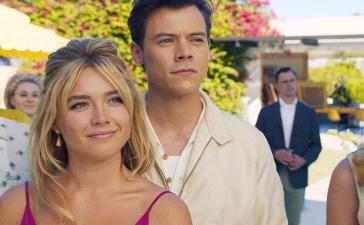
In the first third of the film, the audience is introduced to Margaret and realizes that Frank and the other neighbors are gaslighting Alice into ignoring her concerns. To me, this characterization catapults the plot into motion. Still, the audience
lacks clarity in the story without an in-depth focus on Margeret’s past in Victory and her relationship to Frank and her husband.
A lot of Wilde’s press appearances for Don’t Worry Darling featured an emphasis on her claim that it would show female pleasure in a nuanced way that audiences are unaccustomed to seeing on the big screen. Compared to movies of the same genre, or any movie with a heterosexual couple, the intimate scenes in Don’t Worry Darling do focus on the satisfaction of Alice rather than Jack. Nonetheless, the overarching themes of the movie overtake this message. In retrospect, the placement of the film’s sex scenes felt hasty and unimpactful. Although I understand the effect these moments were supposed to have on the viewers, to understand the unique love between Alice and Jack, the moments felt uncomfortable and forced.
As the story continues, we see Florence Pugh’s experience in the thriller genre take hold as she ranges from a happy wife to an exacerbated friend. Going into the film, many critics had doubts about Harry Styles’s acting skills because he had only ever acted in Dunkirk (2017), a Christopher Nolan film that inspired Wilde to shortlist Styles for Don’t Worry Darling . However, Styles as Jack was exactly what the role needed. Many often compare Styles to the likes of James Dean, and he shines in the role of a doting husband who wears nice suits and drives a fancy Corvette. His innate handsomeness and charm make the audience fall for him and his marriage to Alice, perhaps exactly as Olivia Wilde wanted. While it felt hard to separate the Harry Styles we know as a singer from the actor on the screen, he was able to fill the role of Jack well and hold his own in important moments in the film. On the other hand, he
almost seemed funny acting next to Pugh, who dominates this genre. The chemistry between Pugh and Styles was palpable, but as their relationship slowly gets brought into question, their dialogue becomes more choppy and their performances stop existing on an even playing field. Although Styles shined in his emotional and expressive portrayal of Jack, he was nowhere close to the revelation that Pugh was as Alice.
Despite critics’ despise for Styles casting in Don’t Worry Darling, I found major issues with other casting choices. Two characters, Violet (Sydney Chandler) and Bill (Douglas Smith), really stood out in terms of distraction to the plot. Their plotline as a couple felt unnecessary, and their lines were even more awkward and forced.

Furthermore, Nick Kroll’s role as Dean, a higher-up at the Victory Project and one of Frank’s staunch supporters, felt plopped into the cast. Kroll stood out due to his reputation as a comedian and not a dramatic actor, and the audience’s inability to view him in the context of a 1950 husband. Additionally, many moviegoers struggled with Olivia Wilde choosing to cast herself in the supporting role of Bunny, Alice’s close friend in Victory. However, I thought Wilde succeeded as the movie’s primary comedic relief, along with another wife Peg (Kate Berlant), who both kept the plot moving.
In an interview with Interview Magazine, Wilde explained she was struggling to cast Bunny’s role because expenses had depleted their budget, and ultimately she chose to play the role rather than finding an actress who would work for a cheap salary.
While many aspects of the script and casting choices fall short of the original script’s full potential, there are elements of the film that surpass all expectations. For one, the cinematography is breathtaking and boosts the movie’s status to a whole new level. The stellar
costuming and set design were other aspects of the movie that captivated all audiences. The carefully curated clothing in the film added important details to the time period and convinces us that Victory is as perfect as its outfits. Costume designer Arianne Phillips even won the Campari Passion for Film Award at this year’s Venice Film Festival.
One of my main issues with all the baseless rumors surrounding the project, specifically those targeting Wilde, is that they seem rooted in sexism. Even if all the rumors about Wilde were true, which they don’t seem to be, it wouldn’t be half as bad as the proven allegations against many famous male directors. For example, David O. Russell has admitted to sexual misconduct, and a handful of famous actors, including George Clooney, called him out for creating a toxic environment on set. However, this has not derailed his career whatsoever, and his new film Amsterdam is set to make bank at the box office. Hateful rumors about Wilde have spread to the masses and possibly compromised her career as a female director. It will be interesting to see if they will derail her future in the industry.
All in all, Don’t Worry Darling had all the shiny aspects of a big-budget Hollywood film, but something was missing. Pugh’s performance stood out, but supporting performances from KiKi Lane, Chris Pine, Harry Styles, Gemma Chan, and Kate Berlant all held their own and added important pieces to the telling of Wilde’s story. Despite many viewers’ dismay, the ending was a neatly wrapped bow. It left many aspects up to the viewer’s discretion and left people thinking. I think the ending was perfect for this film and genre because the film dares us to question our lives, our reality, and the social norms ingrained in our society. As the film inquires, what are you willing to risk for the perfect life?
6 SPOTLIGHT 7 October 2022 • The Scripps Voice
Photo
Courtesy of Entertainment Weekly
Photo Courtesy of The Atlantic
Bodies, Bodies, Bodies: The Laziest Take on Gen-Z since Millennials Discovered Tik Tok
By Anna Peterson ‘25 Staff Writer

B
odies, Bodies, Bodies, A24’s hit horror film of the summer, provided me with my favorite elements of the scary movie genre while also delivering one of the most superficial critiques of young people I’ve seen to date.
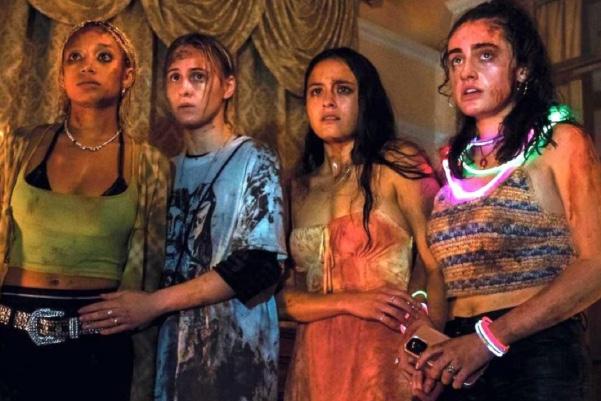
The story follows the lives of couple Sophie (Amandla Stenberg) and Bee (Maria Bakalova). After spending a romantic afternoon together, they travel to childhood friend David’s (Pete Davidson) home for the most anticipated party event of the year: a massive hurricane. Upon arrival, we meet some of the wackiest rich kids that Hollywood can paint: Emma (Chase Sui Wonders), Alice (Rachel Sennott), and Jordan (Myha’la Herrold). Unlike the rest of the collegeaged crew, Alice’s boyfriend, Greg (Lee Pace), is roughly ten years older and is a stranger to the rest of the group, immediately positioning himself as suspect numero uno.
“I could imagine meeting these characters in real life and likely sharing some pseudo-intellectual conver sation with them at a 5C party.”
Following their arrival and the onset of a hurricane no one seems concerned about, the group begins to indulge themselves in all the necessities of a good party: a marijuana-laced chocolate cake, glow sticks, and a game of, you guessed it, Bodies, Bodies, Bodies . Each

person draws a slip of paper, indicating one player as the killer. However, the game quickly devolves as tensions arise, fights erupt, and the characters, for the first time, start to address the literal hurricane threatening their safety. Oh, and in typical slasher style, one by one, each character faces their demise in some sick twist to this game of fucked-up Clue.
While I have plenty to say about director Halina Reijn’s half-assed commentary on my generation, I first want to address all the things I did like about the movie. This film embodies the same campy suspense and horror film fanatics that made me love the genre in the first place. It elevates and modernizes the cliche teen slasher into something new and palatable to young audiences. Additionally, the casting and writing choices for the characters were brilliant. The film does a fantastic job curating an authentic sense of youth without misusing outdated buzzwords or capitalizing on the media’s perception of trendy.
I could even imagine meeting these characters in real life and likely sharing some pseudointellectual conversation with them at a 5C party. The beauty of this film is in its ability to satirize and accurately capture the niche reality of being a twentysomething trust fund baby.
“This film embodies the same campy suspense and horror film fanatics that made me love the genre in the first place.”
On a technical level, I would also like to give props to the musical direction this film takes. With features by Charli XCX, Azealia Banks, and Slayyyter, it was hard not to feel like one of the girls. It elicited the same feeling of getting ready in your dorm room before a big Saturday night with an unbridled sense of enthusiasm.
“Reijn runs with this ironic narrative about young peo ple, but the conclusion falls flat.”
With complete transparency, I found this movie super fun and mostly on target for relaying a story about Generation Z up until the last ten minutes. The ending left me thinking “Really? That’s
all you could come up with?” which ruined all the truthful, exciting aspects leading up to it. Reijn runs with this ironic narrative about young people, but the conclusion falls flat. The film’s progression warrants an intense final moment or, at least, a sincere reflection of the harm social media can cause. Alternatively, the audience receives a simplification of what could have been an innovative plot line.
If you’re in the mood for an upbeat, girl’s night-esque take on the classic horror movie, I wouldn’t shy away from this film. Just be ready to encounter a bitter disappointment at the end. My recommendation: stop three-fourths of the way through.
7SPOTLIGHT Voice • Volume XXXI • Issue One
Photo
Courtesy of A24
Photo Courtesy of Vulture
Who Says We Have to *Let it Go*?: A Review of “High SchoolMusical: The Musical The Series” Season 3
By Belen Yudess ’25 Social Media Manager
High School Musical: The Musi cal The Series (HSMTMTS) de buted its third season on July 27 of this year. This season followed the current East High Leopards (they’re not actually wildcats) to Camp Shal low Lake, a performing arts summer camp. Just that alone should be a sign of the fruitiness ahead.
In the most meta plot that came to Disney in a fever dream, Corbin Bleu from the original High School Musi cal franchise, makes a special an nouncement. The camp will be put ting on a production of Frozen, and the rehearsals and inevitable drama will be filmed for a Disney+ docu mentary.
Why does anyone watch this ridic ulous show? How do you keep track of the ever shifting relationships? Could my suitemates hear my high school friend and I cracking up at 2 a.m. while group watching the sea son finale? These are all questions you, and definitely my mom, may be asking.
As a dedicated fan, I personally cannot tell you why I watch. Maybe it’s for the sheer outlandishness of the dialogue, (“I just feel naked with out my angst,”), or the Gleek in me craving abrupt singing battles. What I do know is that on the eve of July 26 I anxiously awaited season three’s arrival and began, as the trailer so optimistically announced, a “sum mer we all remember.” And oh, how it was.
“ Why does anyone watch this ridiculous show? How do you keep track of the ever shifting relationships? Could my suitemates hear my high school friend and I cracking up at 2 a.m. while group watching the season finale? These are all questions you, and definitely my mom, may be asking.”
The first dramatic change of the season is the absence of the show’s original protagonist: Nini. Nini de cides to miss camp and heads off to California with her moms for a fun vacation and to explore her abilities as a songwriter. At the end of her three episode stunt, Nini realizes that she has outgrown East High, leading to her decision to permanently move to California for her senior year.
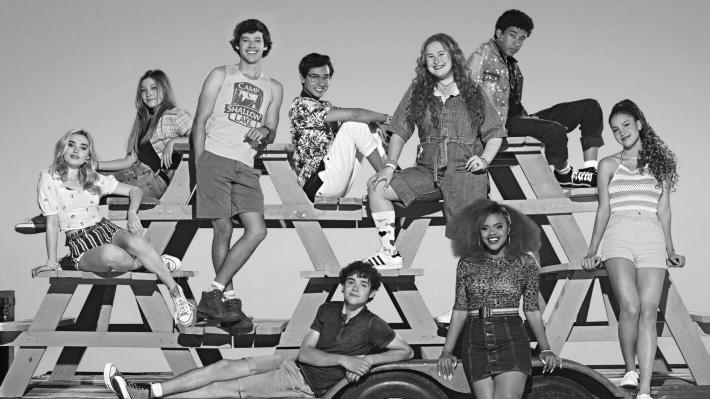
Although Nini’s absence and inevi table departure from the show left a sour (get it?) taste in the mouths of many fans, this plotline was a strong move for her character. Nini is deter mined to discover her artistry apart from her relationship with her ex boyfriend Ricky (played, of course, by Joshua Bassett). This storyline depicts the confidence that comes from self-growth, and empowers young adults to go after the future they see for themselves.
Down a leading lady, Gina (Sophia Wylie) becomes the main female protagonist. Wylie absolutely shines in this new role, nailing her basket ball inspired duet with Corbin Bleu, proving the latter can in fact, dance.
However, she is not given the chance to explore her own identity or relationship with EJ (Matt Cor
This imitates the exact plotline of the first season, in which EJ must play Ricky’s best friend while his relationship, originally with Nini, crumbles around him. ‘A billion sor ries,’ EJ. The entirety of the second season was devoted to EJ and Gina’s budding relationship and individual growth. Through their friendship, EJ becomes less shallow, and Gina real izes the value of trusting others. All of this work and build up is wiped out by the first couple of episodes when Gina begins flirting with Ricky to get EJ to pay more attention to her. Al though I am not EJ’s biggest fan, he does his best to support Gina in her first main role, while also directing Frozen with no adult guidance.
“ Despite the messiness of the show’s predominant straight couple, the queer couples and characters are absolutely thriving!”
But just like with Nini, EJ does not stand a chance against Ricky’s sensitive and attentive nature. Gina eventually breaks up with EJ, and two episodes later, shares her first kiss with Ricky. No time for a break up song there! In repeating this plot line with the same two male char acters, Gina’s development seems dependent on EJ and Ricky. Her relationship is no longer a facet of her character, but the purpose of her character. Gina, and even Ricky and EJ’s, unique personalities become unimportant in their relation to one another.
Despite the messiness of the show’s predominant straight couple, the queer couples and characters are absolutely thriving! One of the positive critiques HSMTMTS has received is its inclusion of queer characters by queer actors. With the show featuring a cast that includes more queer identifying actors than straight individuals, the wildcats are
embracing their pride both in and outside of the classroom!
The last three seasons have fos tered the growth of Seblos, the ship name for Carlos (Frankie Rodriguez) and Sebastian (Joe Serifini), who are depicted as bold, loving, and excel lent duet partners. Their relationship is accepted and celebrated by their family and friends, which allows them to showcase their individual comfort with their sexualities. Al though it is important to represent the coming out process and the different realities concerning queer relationships, it is good to see posi tive inclusion of LGBTQIA+ charac ters normalized in shows meant for younger generations. This pattern was continued with Maddox (Saylor Bell) who makes a few iconic com ing out jokes, and casually mentions her relationship with her ex-girlfriend, Madison (JoJo Siwa).
“ In trying to provide queer representation, Disney rushes through coming out scenes and developments that give almost a comical edge to the experience they had inherently normalized. ”
Throughout the season, Maddox is seen to hold a torch for Ashlyn (Julia Lester). Although this plotline seems to follow the gay girl in love with the straight girl trope, it quickly becomes camp (get it?) when Ashlyn realizes she is queer. After constantly snap ping at Val (Meg Donnelly) Ashlyn realizes she is lashing out due to her misunderstood crush on her (sorry, Maddox). Ashlyn’s eventual realiza tion of her queerness does a good job of showing the sometimes slow, and often confusing process of un derstanding those feelings.
Although it is not clear whether she wants to pursue a relationship with Val, Ashlyn decides to break up with her current boyfriend, Big Red (Larry Saperstein), to explore her sexuality. But after hearing Big Red confess his undying love for her, she forgoes this plan and stays together with him. Ashlyn seems excited to learn more about her queer identity on her own, but after this conversa tion, she falls into the safety net of her relationship. Coming out does not immediately solve everything. It
is ok to be uncertain about what’s next and to take time to learn about what this identity means. Ashlyn is allowed to want to begin this journey individually, but the traditional Disney ‘happy ending’ seems to hinder her ability.
Image courtesy of Sheryl Nields/ Disney nett) without a love triangle being imposed. After several awkward in teractions and intimate moments with Gina, Ricky realizes his feelings for her. How convenient that Gina is cast as Anna, and Ricky is cast as Kristoff in the Frozen musical. EJ is subsequently cast as Sven, making for some excellent pictures of Cor nett in a reindeer costume.
“ Season 3 of HSMTMTS is like the mystery of the woman in the woods: strange, a little too fantastical, but always ends in a laugh.”
But to turn coming out into the new couple’s tennis, Big Red decides to follow suit. In his minimal appear ance in the season, Big Red takes the common “I’m (insert name here) and you’re watching Disney Channel” template, and uses it to come out as bi in the last minute of the final epi sode: “I’m Big Red, I’m Ashlyn’s boy friend, and I’m bi!” In trying to provide queer representation, Disney rushes through coming out scenes and de velopments that give almost a comi cal edge to the experience they had inherently normalized.
Big Red’s coming out also seems like a way to enforce the idea that Ashlyn and Big Red’s relationship is queer. Although Ashlyn’s decision to remain with Big Red seems forced, she represents how one is still queer, even when dating a straight mem ber of the opposite sex. Big Red’s sudden and unnatural coming out is framed more as a reinforcement of his relationship identity, rather than a declaration of his own.
Although this season did have some kinks in the road (probably the same one Nini drives on to get back to California), it does feature some in credible songs and quotes. Maddox, her brother Jet (Adrian Lyles), Carlos, and Sebastian’s cover of Camp Rock 2’s “Wouldn’t Change a Thing” is an upbeat ode to the strength of love. And Nini’s original song “You Never Know” is a reminder to enjoy one’s youth and the adventures of growing up. The audience was also blessed with the vision of a clueless Ricky asking whether he and EJ would play, “friends, enemies, or *lovers*” in the musical.
Season 3 of HSMTMTS is like the mystery of the woman in the woods: strange, a little too fantastical, but al ways ends in a laugh.
7 October 2022 • The Scripps Voice • Volume XXXI • Issue One 8 • Arts and Entertainment
The Perfect Playlist to Put You in the Fall Spirit

 By Abbie Bobeck ‘26, Annika Lindberg ‘26, Mina Jung ‘26 Staff Writers
By Abbie Bobeck ‘26, Annika Lindberg ‘26, Mina Jung ‘26 Staff Writers


Happy fall, Scrippsies! Although the sun is currently shining bright in Claremont, the atmosphere of fall is starting to creep through campus. As midterms pickup and pumpkins show up all around, we want to enter the headspace of true autumn. To us, fall means so many things, from changing leaves to a little spice in your coffee, but most importantly, melancholic and sultry tunes.
Three of us staff writers for The Scripps Voice have collaborated to compile the perfect fall playlist to transport you into your favorite fall scenes. We drew inspiration from themes of being paranoid, missing someone you love, and self-reflection. Our sad Scrippsie aesthetic is featured throughout the playlist and we hope some of these songs will provide you the same comfort as a cozy blanket.
This article highlights a few songs that each of us added to the playlist, and why we think they contribute to the autumn vibe. Feel free to scan our graphic to listen on either Spotify or Apple Music, happy listening!
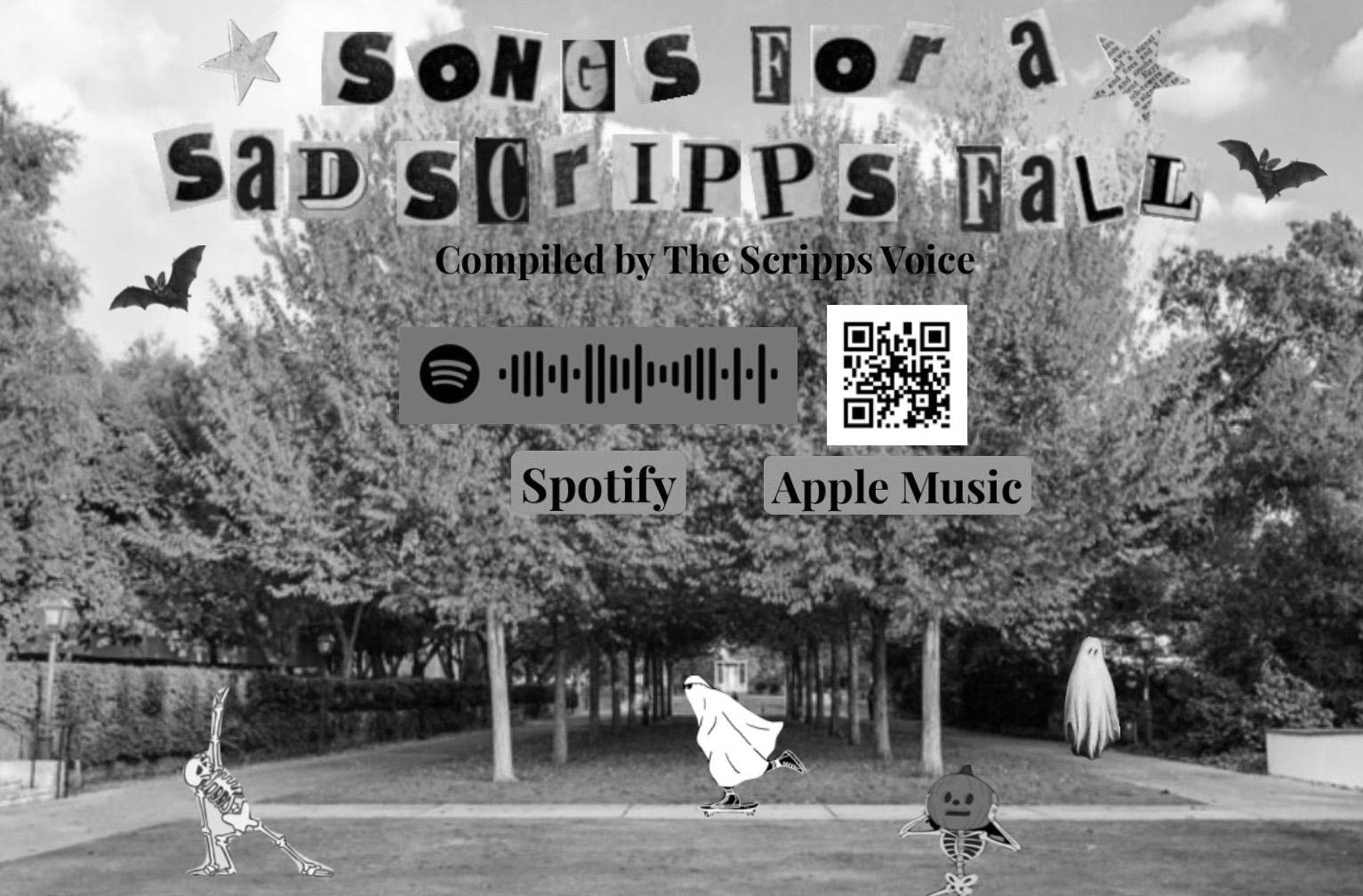
Annika’s Top Picks: “doo msday” by Lizzy McAlpine
My top Spotify song for this month, “doomsday,” is off Lizzy McAlpine’s third album five seconds flat, and is perfect to get you in your feels just in time for fall. Throughout the song, McAlpine describes the feeling you get when you know a relationship is almost past its expiration date and must prepare yourself for the inevitable heartbreak. Full of funeral analogies and sad instrumentals, “doomsday” tugs at your heartstrings in all the right ways and, at least for me, triggers feelings I know all too well.
“I Saw the Moon” by Peach Fuzz
Si milar to “doomsday,” “I Saw the Moon” also tells the story of a relationship gone wrong. The couple in the song holds onto their good memories as they search for forgiveness in each other after their relationship has soured. However, they knew their relationship was headed in the wrong direction. The lyric “we got along like a house that’s on fire” symbolizes the pain of knowing that it might be time to give up even while fun times of the past still linger. Peach Fuzz uses acoustic instrumentals and soft harmonization to give the song the full “sad girl autumn” aesthetic, making it a perfect addition to the TSV fall playlist.
Mina’s Top Picks: “Slow Like Honey” by Fiona Apple
“Slow Like Honey” is an atmospheric masterpiece that feels spooky, foreboding, and slightly jazzy. In this song off her first album Tidal, Fiona Apple writes about haunting someone and drawing them in with her “big secret.” Full of building instrumentals and dark lyrics, this song is perfect to listen to on an October night. I would personally recommend sitting in one of the creepy old living rooms around campus and imagining yourself as a mysterious ghost.
“ Heat Lightning” by Mitski
With a beautiful piano transition and gorgeous imagery, Mitski singing about insomnia and watching a storm over a driving beat and layered harmonies is the ideal soundtrack for an existential crisis. The lyrics have many double meanings and metaphors, and the instrumentals transport you to a new dimension. I like sitting in my room and staring at the wall to this one. Mitski never misses.
“Acolyte” by Slaughter B each, Dog
Perfect for walking around campus, this song tells the story of a new relationship and the uncertainty that comes with it. It makes you nostalgic for something you may never have even experienced. Even though the lyrics are slightly sad, the upbeat instrumentals get your feet tapping a little bit. I would recommend listening to this with a spicy chai from the Motley, as I feel the two complement each other well.
Abbie’s Top Picks:
“S eason of the Witch” by Lana Del Rey

L ana Del Rey’s cover of the 1966 psychedelic rock hit by Donavan adds a new sound to a classic. Lana’s sultry tone blends effortlessly with the enticing chorus and she brings new life to an already amazing song. The song plays on the illusions and paranoia of one’s own psyche, adding the perfect sinister mood to our fall playlist. This cover adds some spice to your fall and is the perfect accompaniment for slowly strutting on your way to class.
“Dark Red” by Steve Lacy
Ste ve Lacy’s “Dark Red’’ is about letting your deepest insecurities get the best of you in a relationship. Another nod to paranoia, the song ties wearing dark red lipstick to feeling confident and independent. Lacy’s pleading lyrics and smooth voice play off one another to encapsulate a feeling of longing and fear that something bad is about to happen to you. These feelings of suspense and reflection sum up the ins and outs of a sad Scrippsie fall.
“Dreams” by The Cranberries
“D reams” is reminiscent of a crisp fall morning for me. The 90’s song is featured in some classic comingof-age films that bring many of us a sense of nostalgia. Not only is the song extremely comforting, but it feels like you’re starring in your favorite fall flick when you listen to it. The song’s message is about changing with a new love as the leaves do. The song adds a soft optimism to a fall day.
7 October 2022 • The Scripps Voice • Volume XXXI • Issue One Arts and Entertainment• 9
Don’t Rush Friendships – They’ll Come
When and if They Were Meant to Be
By Ellen Hu ’24 Editor-in-Chief
A rriving for my study abroad program in Copenhagen felt just like NSPO: the quick introductions, the standard questions about each person you meet, and feeling like you’re moving too fast for anyone to really get to know you (and of course vice versa). As an introvert, making friends in these situations induces a level of wariness that often impacts how many people and how often I choose to interact with others.
Situations like these are bound to happen when you and many others enter a new environment, but if I’ve learned one thing over the past month abroad, it’s that friendships can’t be forced. Time is key, and embracing the fact that friendship doesn’t happen right away allows us to better understand our communities and ourselves.
That’s not to say that embracing this is easy. Within the first hour of my arrival in Denmark, I was whisked away to my student housing and introduced to the nine people I would be living with for the rest of the semester. Well, 21 if you count the suite that was situated right across from the hall.
For the next few days, I was surrounded by these 21 people and the possibility of friendship. Yet, I struggled to see anything more than surface-level connections when it came to my situation. At first it went on for a few days, and then it stretched into half of a month.
It was especially difficult when it felt like everyone else around me was friends left and right. While all of my housemates were bonding to the highest degree, I was distressed. I kept asking myself what I was doing wrong and what I
needed to do to make myself fit in.
I tried really hard – I talked to them in our common area and tagged along on trips around the city. We spent even more time together during weekly evening activities and I got to see how nice each of them were. Still, it always felt like there was an invisible barrier that I couldn’t break through to get below pleasant small talk in our conversations.
I began to feel isolated and extremely lonely. While my suite was out together doing an activity I wasn’t interested in, I would go out on my own to explore the city. Not fitting in wasn’t stopping me from doing what I needed to do to say I experienced Copenhagen, but my time didn’t feel like it was as
The Infinity Between Were and Are
By Belen Yudess '25 Social Media Manager
We knew each other Once.
Introductions are necessary
When shared silence seeps out the door.
When you saw me Last, I was still so lost.
And though I haven’t reached the destination
I’m not as far off.
You weren’t the North Star Nor the moon
Or the sun
But you were a compass,
Something much more practical than a feeling in my gut.
You were beautiful
The way you danced with your words.
A grand jete across my clumsy heart
Kept me stumbling for a way to keep up.
“You were”: Indicating an absence
Of something that once was. But maybe it’s been that way for a while,
Because if I noticed it earlier, You could still be An “are”.
memorable as it could be.
In the moment I couldn’t have wanted to be with other people more, but in retrospect I’ve realized just how formative the solo time was. It taught me a lot about how I see the world and everything I wanted out of my time abroad – especially when it came to the activities I wanted to experience and the people I needed to do them with.
For example, I realized that I’m more of an active traveler and want to get out and walk more than a lot of the people I was surrounded by. I’m also a morning person, and getting a head start on all of the other tourists was something that I valued, but others put lower on their priorities.
It wasn’t until I began branching out – getting out of the close-knit group that was forming – that I realized there were people that I connected with on a deeper level. And those people were amazing.
I began attending the student of color affinity group events and met so many people who were feeling the same way I was or who held values similar to my own.
I began doing more with them and soon found that I was having conversations that flowed in a comfortable way. It was refreshing.
I also found comfort in my coworkers. While abroad, I have joined a small group of student photographers hired by my program. From the moment we all met for our first meeting, nothing felt too forced. We jumped at the opportunity to discuss our photography experiences while in Copenhagen and all of the tips we had for each other.
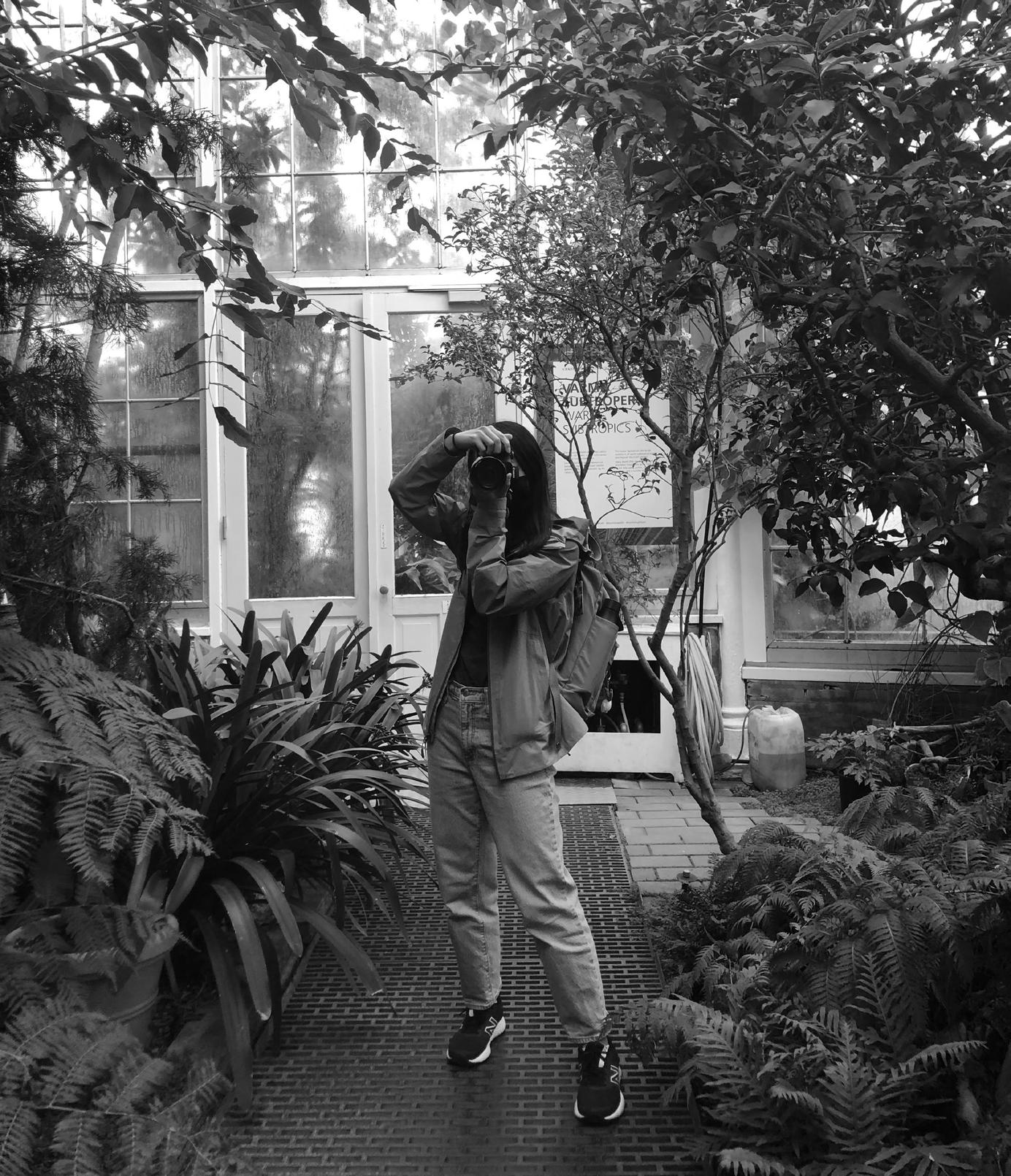
From there, my social circle only grew. Success in the realm of friendship came down to where and when I was searching. I was overjoyed when I finally felt like I had made deeper connections, and if anything the amount of time it took for me to reach that moment made it all the sweeter.
As I look back on the past month, I realize how many times I’ve been so focused on trying to make friends that I become impatient and worried when it doesn’t happen quickly. It’s always felt like time was never on my side, but now I know that my enemy is not the clock as it ticks away. It’s been me and my assumption that friendship comes in a heartbeat.
Ultimately, sometimes it doesn’t come at all – and that’s okay. As long as you embrace everything you are and find the people who do that as well, does it really matter how long it takes?
The woman you love cuts mangoes
By Rebecca Allen ’25 Staff Writer
The woman you love Cuts mangoes And serves them cold. Sloppily sliced, Their juice Glazes her hands a Slippery orange.
Your gaze; Her back to you; The careless chunks She deposits into the Porcelain bowl. When she turns
And faces you, her eyes are Questions you fail To answer.
The woman who Loves you Also despises you. Still, she cuts mangoes.
7 October 2022 • The Scripps Voice • Volume XXXI • Issue One Feature • 10
Photo Courtesy of Ellen Hu '24
Lunchtime Special:
How Scrippsies Serve at Malott
By Angelina Astillero ‘23 and Quincy Johnston ‘24 Staff Writers
H i everyone! Our names are Angelina and Quincy, and we are this year’s fashion columnists! As big fans of Maddie Moore ‘22, the pink princess herself @mad dieshortcake, we wanted to con tinue showcasing the unmatched joyful fashion of Scripps College.
A typical uniform on most col lege campuses best resembles the disheveled look of an exhaust ed student. But at Scripps, every day is a fashion show, and even sweatpants and pajamas are somehow made to look hot.

We have always admired the in dividuality and attention to detail Scripps students put into each outfit. From all the handmade ear rings to expressive hair stylings, Scripps is a community where au thenticity and creative exploration thrive.
Because procrastination is the name of the game, our two-weeklong project documenting the best of Scripps fashion quickly became a last-minute scramble at a single Malott lunch to find fits for our first article. So, on the last day of our article’s deadline, we set out to find all the jorts, long skirts, and vintage tops that de fine atypical Scripps fashion.
First on the catwalk was none other than Mia Fenyak ‘25. The birthday queen of the hour, Fenyak humbly accepted her title of best dressed for her essential Dansko purple clogs, perfectly tailored flo ral a-line skirt, and matching tank. Her glass soldered earrings from @jwc.glance repped the student pride that always seems to spill out of the Motley into Seal Court.
Heading into Mallot, we ran into our suitemate/soulmate and favorite fashion icon, Alee cia Sharpe ‘23. When we asked to get a photo of her, she broke into laughter, “Y’all like this?!” Sharpe was sporting low-rise camo cargo pants, a cutoff buttoned sweater, and handmade waist beads, ac cessorized with white Birken stocks that she insisted we crop out of the final photo. When asked who inspires her style, Aleecia re sponded without hesitation, “the POC on our campus.”
“I think it’s about embracing identity because there’s not a lot of representation of POC commu nities here. So when we step out, it’s special.”
Next, we stepped in front of Em ily Brainerd ‘26 on their way into Malott, pleading for an explana tion of their foolproof pairing of a green fur-lined vest with a classic headphone/sunglasses combo. One of Brainerd’s friends saw us interrogating them and couldn’t help but join in to poke fun at their choice of a vest in 85 de gree weather. Brainerd’s counter: “’Cause it’s sick.” Brainerd walked us through the story of their thrift ed men’s cargo pants that paired
with the staple Scripps tote bag.
“What I noticed when I first came here is how people played with masculine versus feminine silhouettes,” they said, reflecting on their first month at Scripps. “Lots of basketball shorts. Lots of cargo shorts.”
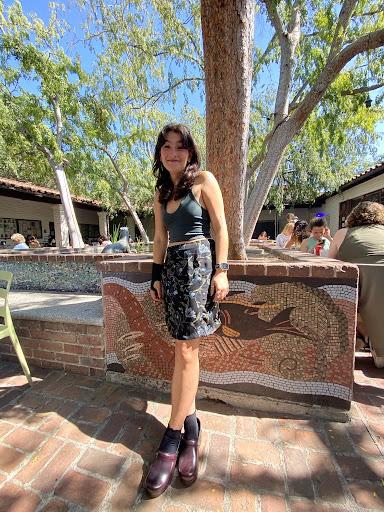
As we took a quick break from our intense grind to eat lunch, we peered over at the students next to us wearing their rendi tion of a quintessential Scripps trend: long comfy skirts. Maiah Oyekanmi ‘26 and Alicia Robadey
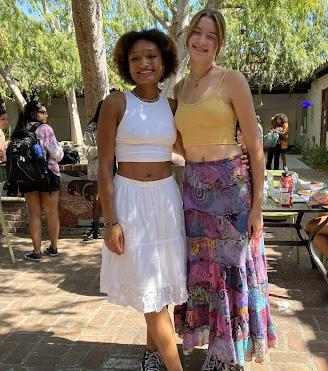
‘26 matched adorably with black converse, dangling earrings, and this iconic hot weather look. Both revealed the stories behind their mismatched earrings and hand me down skirts. One of Robadey’s earrings was recently bought at the Motley, while the other she had created at Mudd’s Maker space. Oyekanmi showed off her mother’s white skirt, which she had once mocked before proceed ing to steal for her own closet.
As the lunch rush died down, we spotted the last fit we wanted — nay needed — to highlight. Ari Daniels ‘23 was rocking a pair of cutoff knee-length jorts held up with a vinted black belt, finished off with hiking boots. After tragi cally clarifying that we were not their style icons (it’s okay Ari, you’re still ours), we laughed our way through the interview.

We love the outfits on this cam pus, even if it means we get out dressed every day. If you made it this far, we are sending love your way, and if you see us on campus, please say hi and let us take awk ward photos of your outfit.
Love,
Two Material Gworls
 Ang + Quincy (insta: quincy_johnston)
Ang + Quincy (insta: quincy_johnston)
Feature • 11
7 October 2022 • The Scripps Voice • Volume XXXI • Issue One
Emily Brainerd ‘26
Mia Fenyak ‘25
Ari
Daniels ‘23
Maiah Oyekanmi ‘26 and Alicia Robadey ‘26
Aleecia Sharpe ‘23.
Deloitte, Equity, and Inclusion? Nina Drinks the Haterade
 Nina Howe-Goldstein ‘25 Mandate of Heaven and Chief Satire Writer in Chief
Nina Howe-Goldstein ‘25 Mandate of Heaven and Chief Satire Writer in Chief
In his recent book Elite Capture: How the Powerful Took Over Identity Politics (And Everything Else), philosopher Olúfẹmi O. Táíwò posits that modern “identity politics” have become far removed from their solidarity-building origins and become co-opted by the powerful to divide. Drawing on the history of Black radical tradition, he dissects “identity politics” with its sibling “deference politics” (“an etiquette that asks people to pass attention, resources, and initiative to those perceived as more marginalized than themselves”) as mere facsimiles of their true liberatory potential, having fallen victim to the worst impulses of liberals and progressives alike.
Dr. Táíwò doesn’t know it, but he actually has based his entire career around the fact that I had to learn how a Deloitte consultant could “personalize their social impact profile in Philanthropy Cloud” as I held an unopened Topo Chico in the Motley.
I’ve had quite the summer. I’ve seen it all, baby: Tony Fauci in a swimming pool; antivax truckers stalking my house. I found out that I’m allergic to red meat. My manuscript got rejected by sixty literary agents. I rewrote it. Entering the fall semester, I only raised one thing in prayer: for everything on this campus to be normal for once.
So you might imagine my surprise when I instead opened the SAS newsletter to learn that Deloitte would be having a DEI-themed info/ networking session in the Motley (of all places). The blurb promised a “unique opportunity to hear from speakers …
with vast experiences in DEI-specific consulting projects,” and encouraged the attendance of “students of color, LGBTQ+ students, and first-gen/lowincome students.”
I RSVP’d, obviously. LOL.
The dress code was allegedly business casual, but it was 103 degrees and I dressed accordingly.
The Scripps Girlies (the best possible way I can think of to describe them; you know the type) wore lovely blouses and heels. The scant few men wore shorts, t-shirts, and Adidas slides. There were six green chairs up onstage, they went entirely unused. They had bottles of chilled Topo Chico; they had no bottle opener.
Other delightful details:
An intro video, against the background of a globe made of multicolor threads, simply declared: “we believe in the power of sharing our identities.” Full stop. They did not know how to pronounce Simu Liu’s name. Emphasis was placed on “supplier diversity,” defined as businesses in possession of ownership from marginalized groups, with nary a word about ethical work conditions for employees or the cultural context through which “diversity” is defined. (I heard “dee-ee-eye” stretched to the point of semantic satiation, and the actual words “Diversity, Equity, and Inclusion” maybe … twice in total.)
At the Club Fair, I was speaking to an anonymous member of SAS, explaining my intent to roast the Deloitte event in the opening issue of TSV.
“Why?” she asked in all earnesty. “What’s wrong with Deloitte?”
Actually, it seems as though most people at this college fail to understand why it’s kinda fuckin weird for SAS to promote a protest against a new
L.A. County jail in the same email as a McKinsey-Goldman Sachs recruiting event. So I’ll make this easy for everyone: megacorporations like these are, on net, bad . They have figured out that they can win over the vague young woke class by preaching the now-standard values of dee-eeeye and promising a good salary; simultaneously, the vast majority of their work furthers the direct opposite aims. I dare you to go to each of their Wikipedia pages and scroll down to the “controversies” sections.
We can’t absolve the Motley of their role in this absurdity, either. In a desecrated post-COVID world, the coffeehouse still remains a fascinating relic of pre-2020 feminism. The wall is lined, as my mother once put it, “with boobs.” One begins to understand why they rejected “Derin Evidson” (names changed to protect the innocent) with upwards of a year’s worth of barista experience; “work history” wasn’t even a question posed by the application, but “woke history” sure as shit was. (Nina, will you be boycotting? Absolutely not. Those sweet chais, light ice, whole milk — they’re calling my name. Besides, I dream of selling my earrings there one day.)
At one point, a Deloitte “practitioner” had emotionally recounted his team’s encouragement of the mention of his boyfriend in the face of “conservative Southern” clients. He never seemed to touch on the ethical weight of his work for those same clients; it was simply a matter of how he felt at the end of the day. That, at its core, seemed so telling and so deeply saddening to me — to that man (if I have to type “practitioner” again I’m gonna vom- wait fuck), such a moment of solidarity was the absolute peak of progress possible to achieve.
What a depressing prospect. I’ve drunk the haterade on all sorts of things lately, and after witnessing such delightful performance art as a Deloitte Diversity Equity and Inclusion event in the Motley, meant to convince the org studies majors of Scripps College that their involvement with the megacorporation designed to do nothing but evade taxes and circulate money to the young professional class will be entirely in line with the values learned here (they have “46.8 percent racial and ethnic diversity among the Deloitte US workforce,” don’t you know), I cannot do anything but drink the haterade with absolute prejudice.
But I can promise you this, in case you were equally weirded-out by such an event: none shall be spared from my haterade-drinking quest — neither the Deloitte-sympathetic among us nor those who disdain it on the grounds of their own moral purity. I have little affection in my heart for our future corporate overlords; nor, for example, shall I absolve all the relentless misusers of the term “mutual aid” on Instagram (spoiler alert, it’s not fucking mutual aid if they’re not in your community). Blocked, blocked, blocked, blocked. None of you are free from sin.
Cancellation will come for me one day, of course. I know it in my soul. On a scale of my king Chasten Buttigieg (as-of-yet-uncancelable) to a party advertised on @5c_nightlife_ (certain to be), I am far on the latter side of the spectrum.
And I embrace it! With open arms, I stand before you, haterade in hand, full of nothing but grievance and my typing fingers.
Welcome back, Scripps. Let’s get this bag.
Opinion • 12 7 October 2022 • The Scripps Voice • Volume XXXI • Issue One
Image Courtesy of Deloitte, Graphics courtesy of Isabel Suh ‘24





















 By Abbie Bobeck ‘26, Annika Lindberg ‘26, Mina Jung ‘26 Staff Writers
By Abbie Bobeck ‘26, Annika Lindberg ‘26, Mina Jung ‘26 Staff Writers









 Ang + Quincy (insta: quincy_johnston)
Ang + Quincy (insta: quincy_johnston)
 Nina Howe-Goldstein ‘25 Mandate of Heaven and Chief Satire Writer in Chief
Nina Howe-Goldstein ‘25 Mandate of Heaven and Chief Satire Writer in Chief